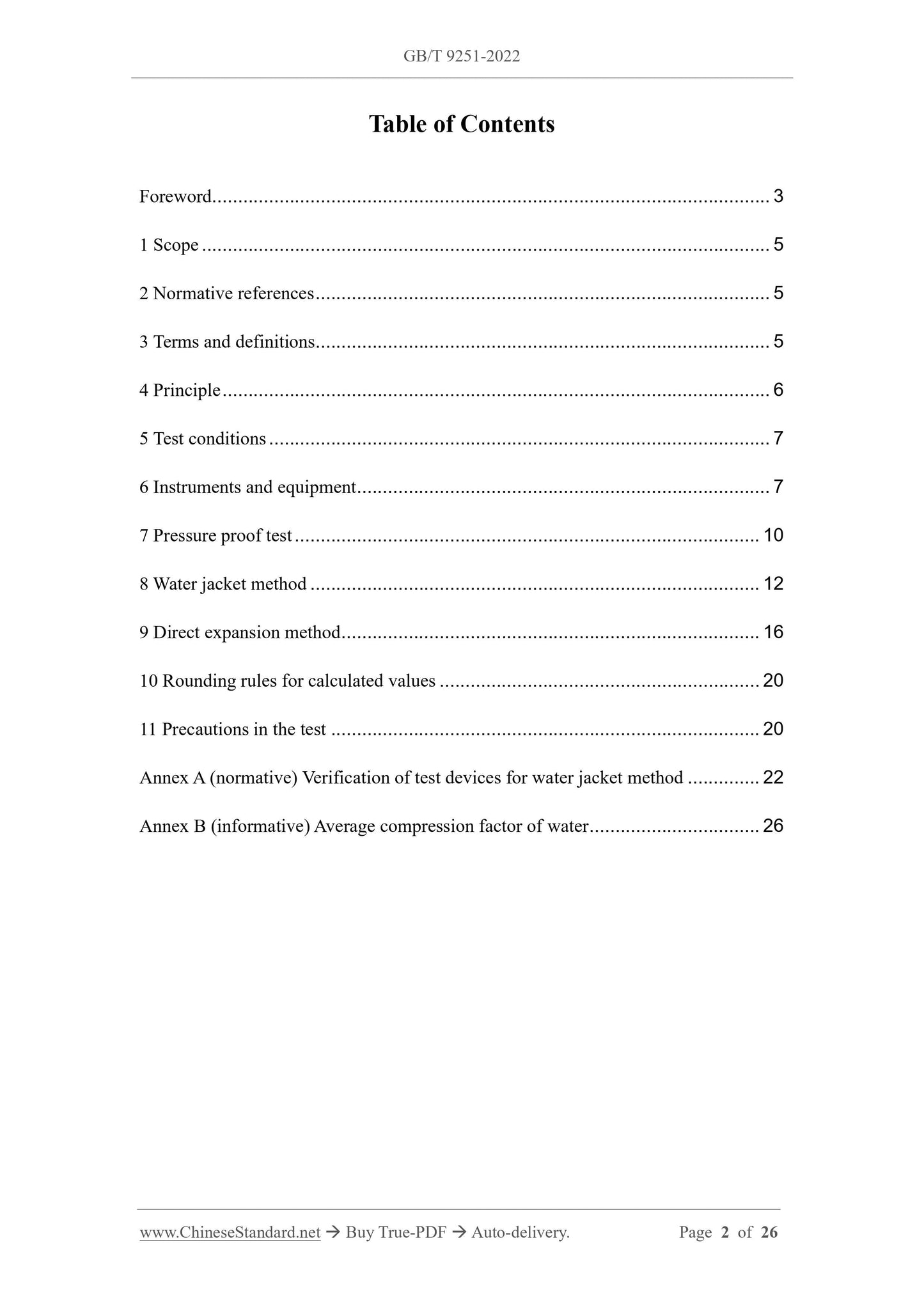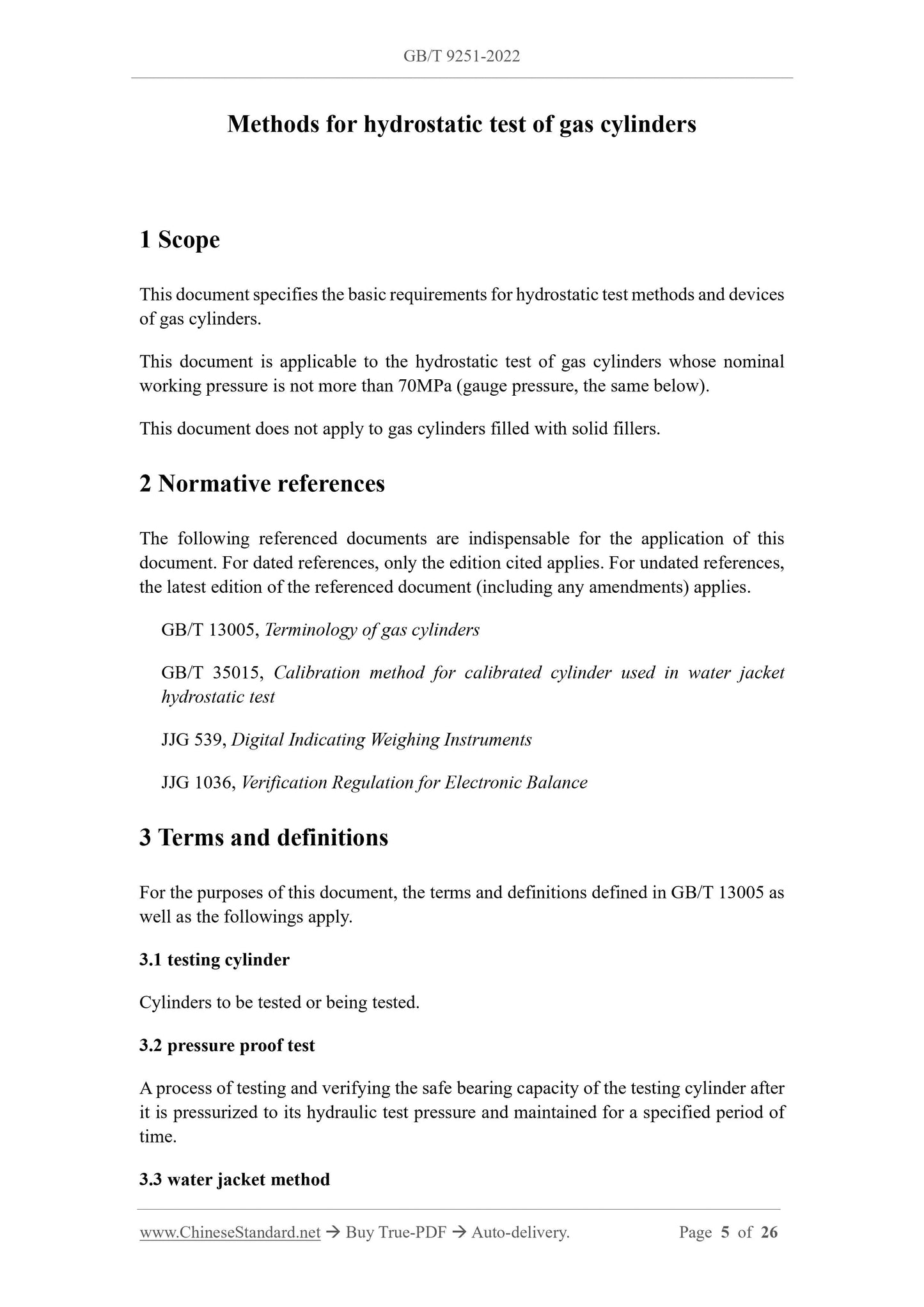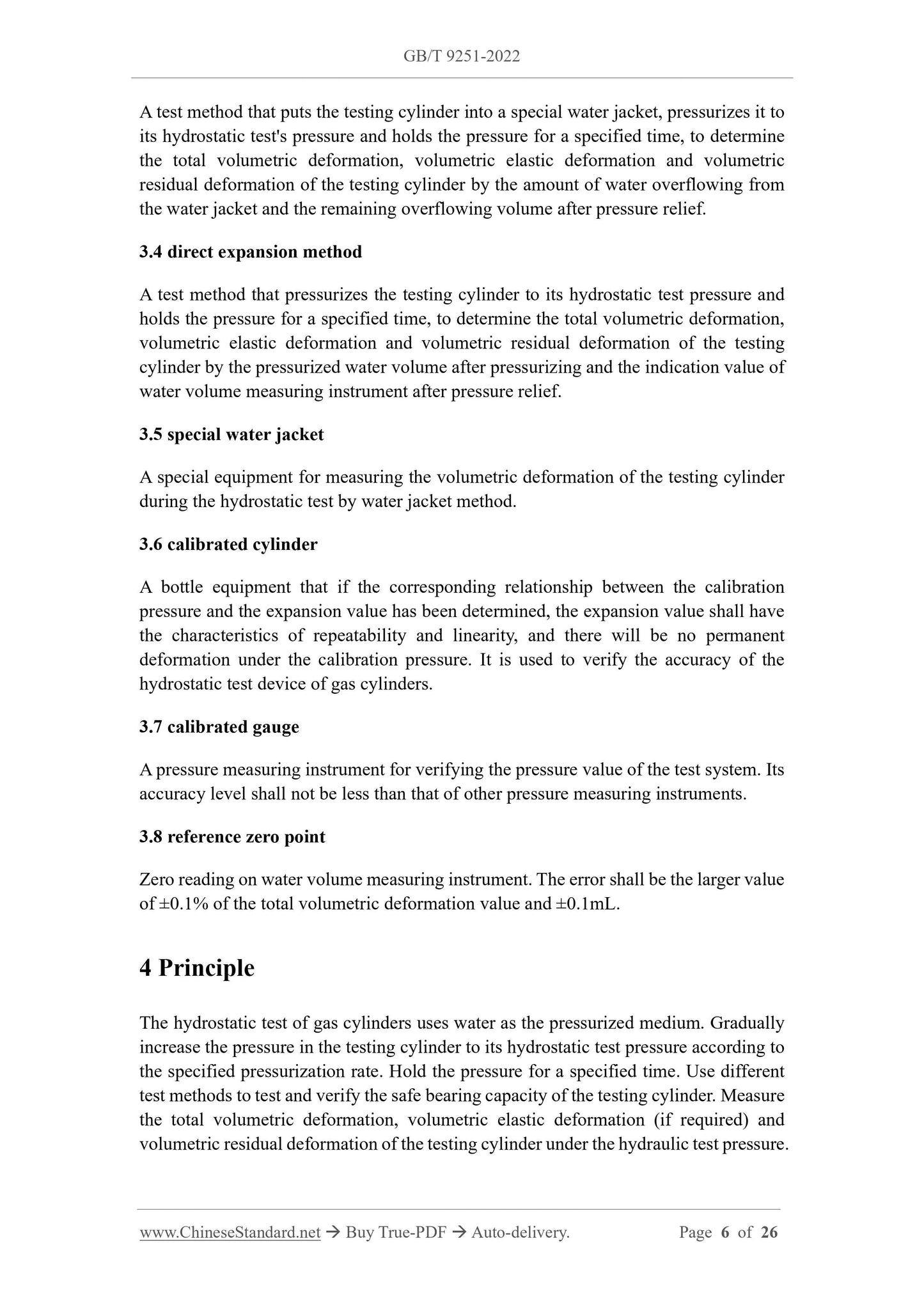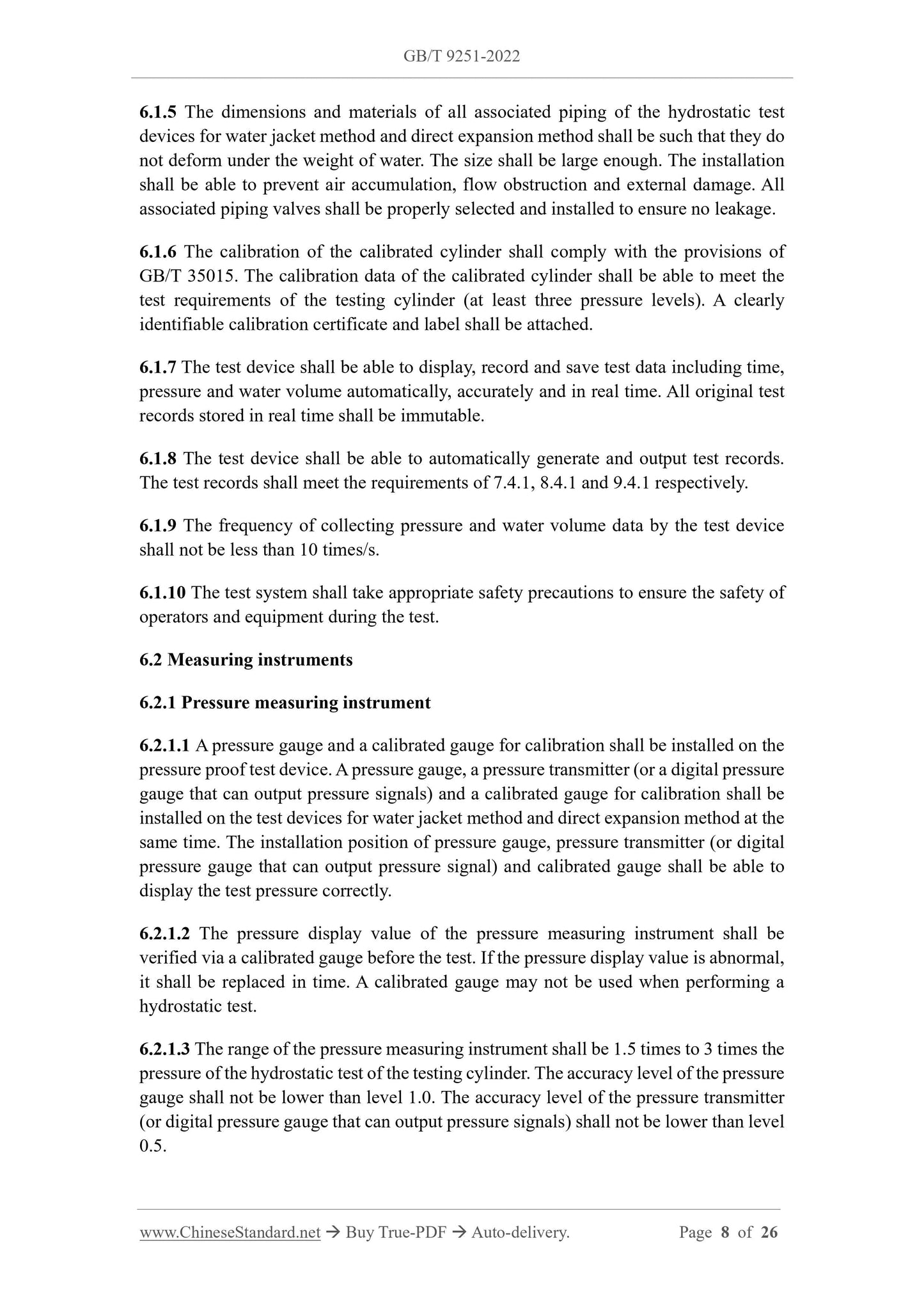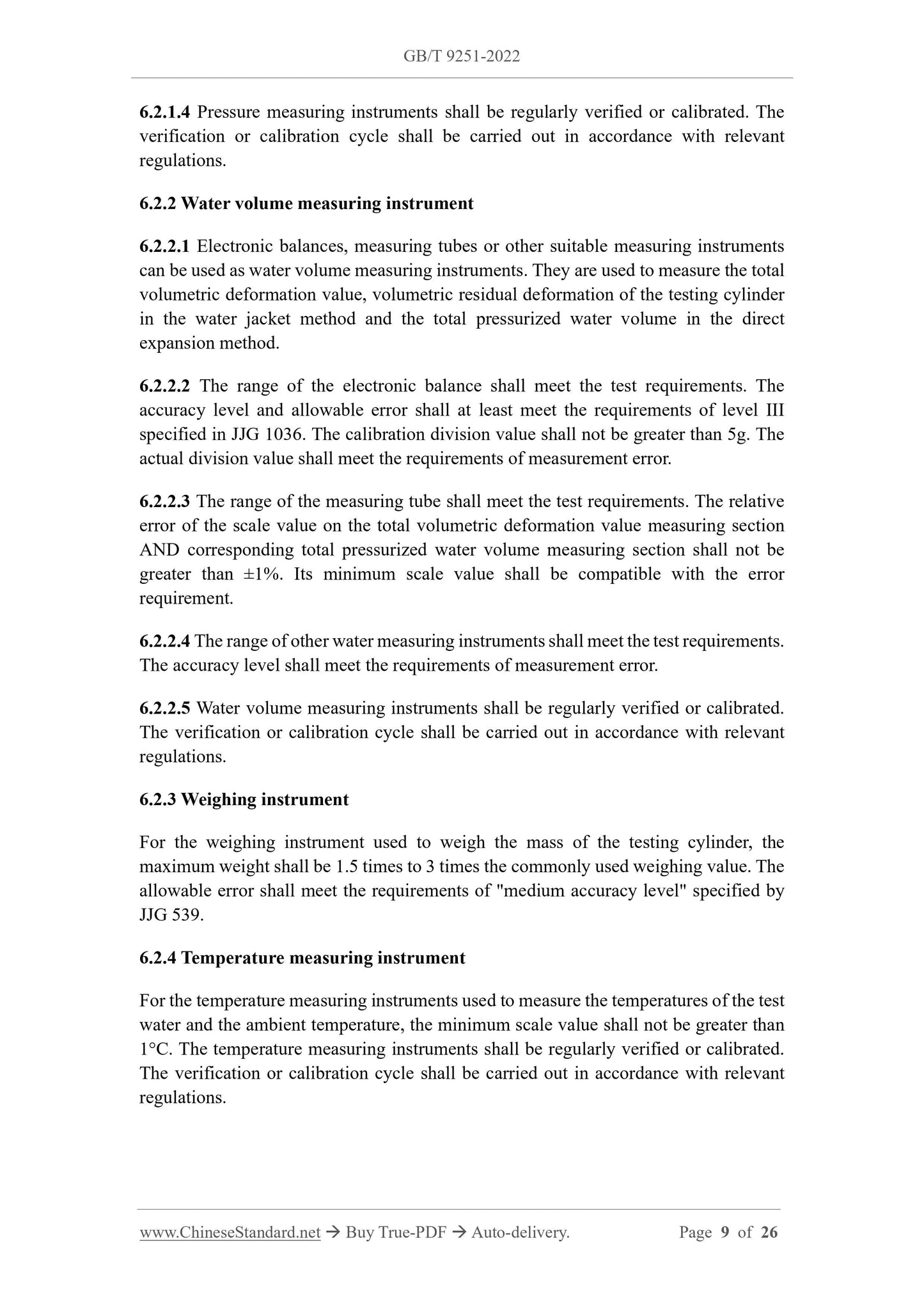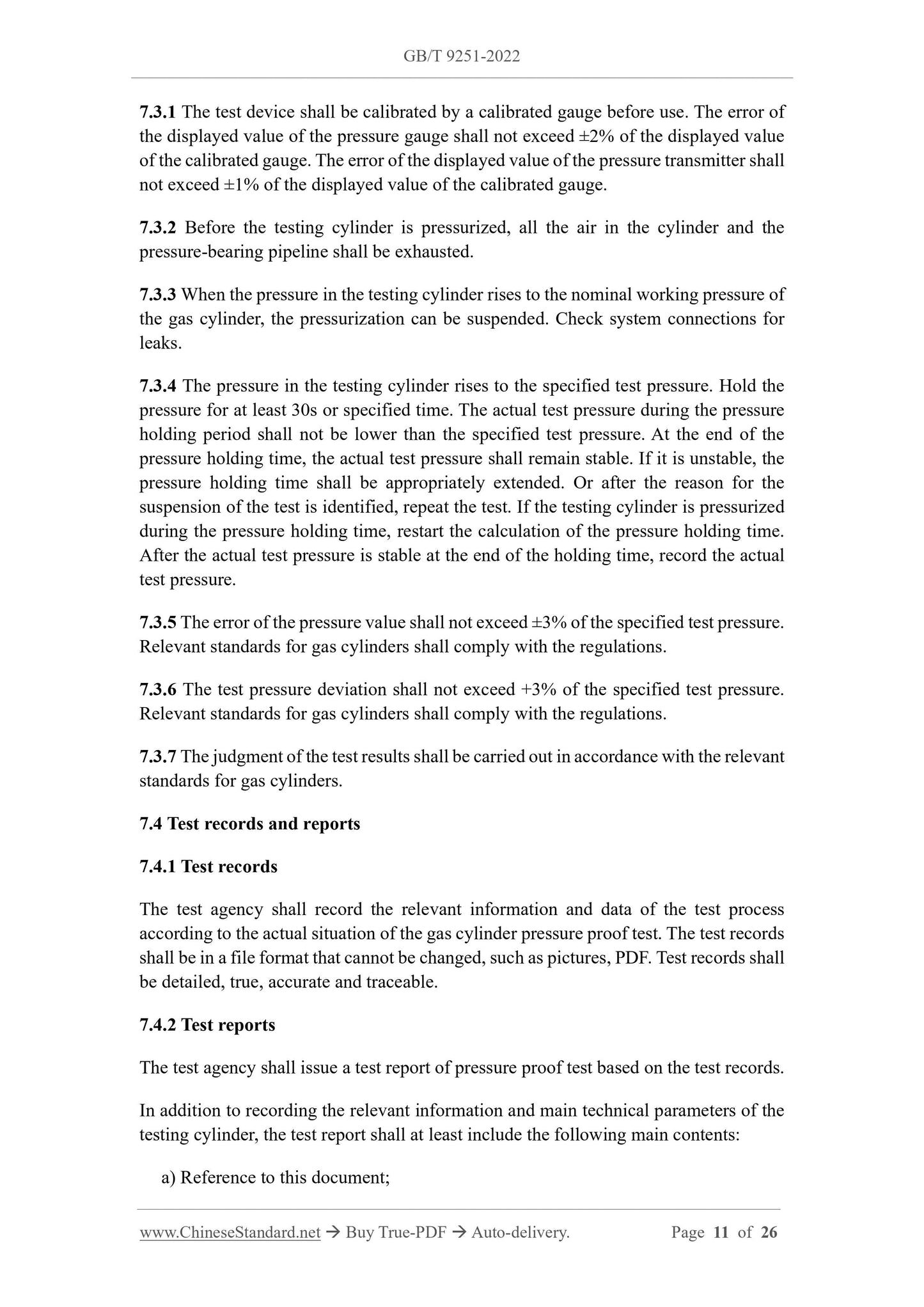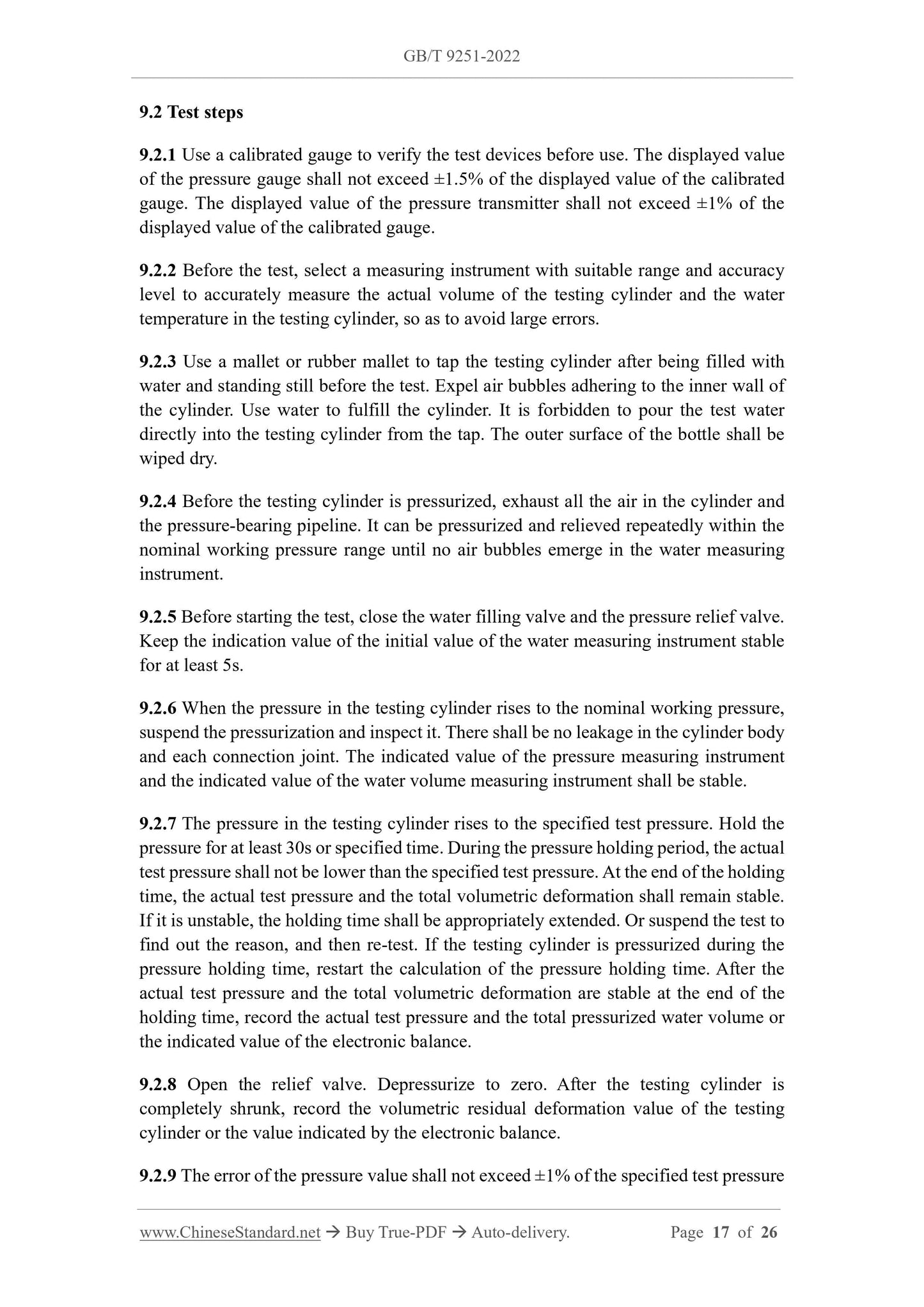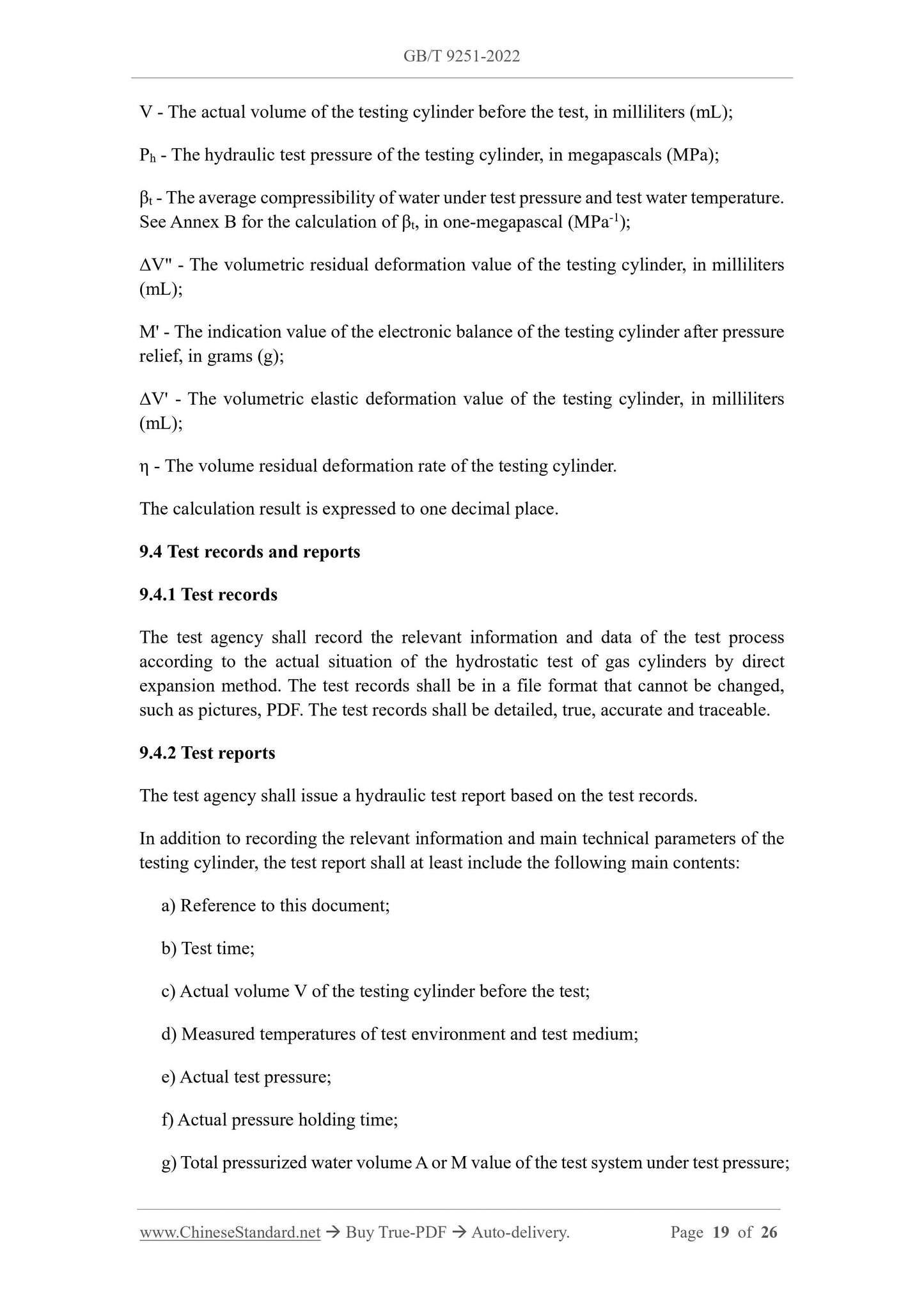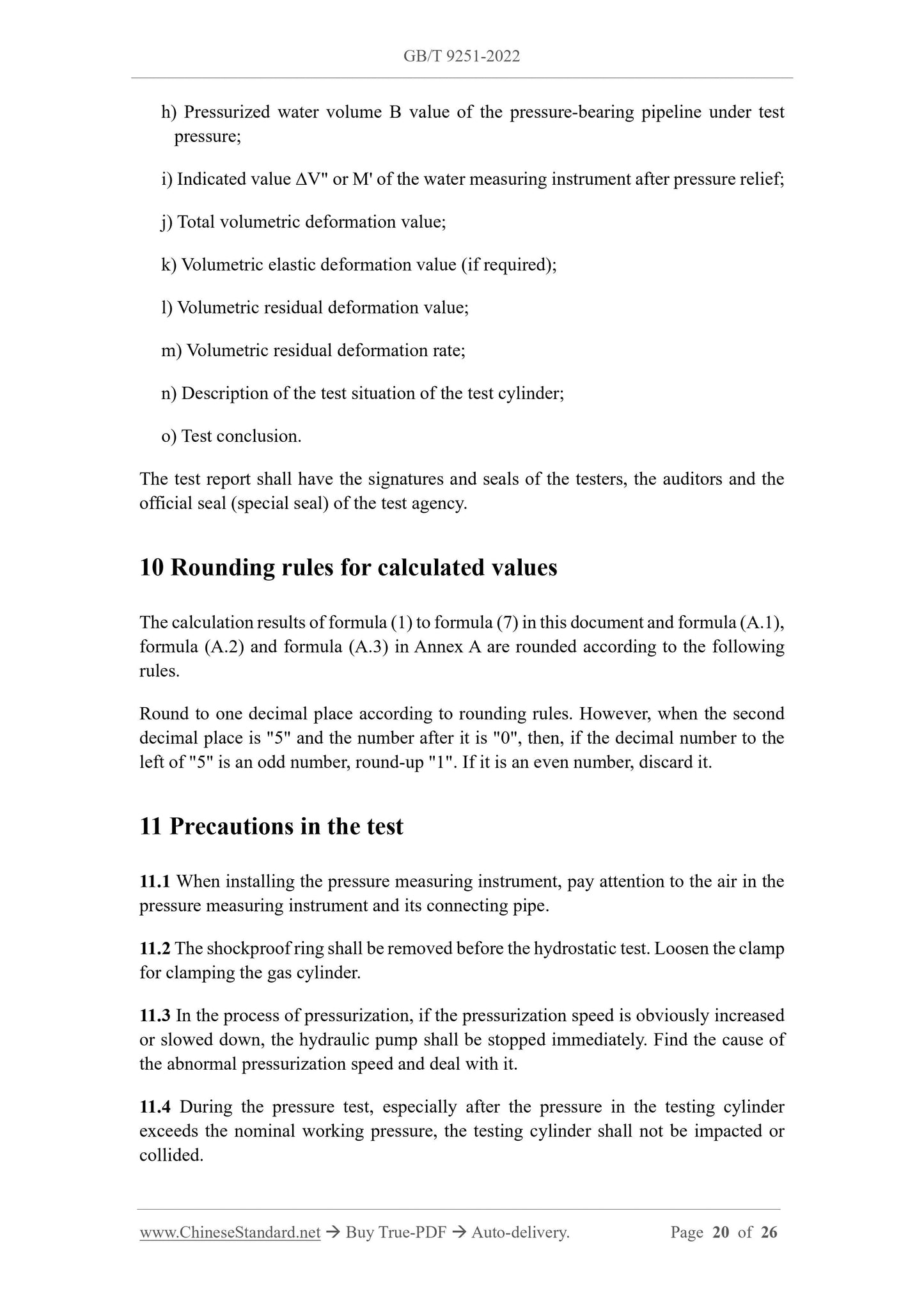1
/
of
11
www.ChineseStandard.us -- Field Test Asia Pte. Ltd.
GB/T 9251-2022 English PDF (GB/T9251-2022)
GB/T 9251-2022 English PDF (GB/T9251-2022)
Regular price
$260.00
Regular price
Sale price
$260.00
Unit price
/
per
Shipping calculated at checkout.
Couldn't load pickup availability
GB/T 9251-2022: Methods for hydrostatic test of gas cylinders
Delivery: 9 seconds. Download (& Email) true-PDF + Invoice.
Get Quotation: Click GB/T 9251-2022 (Self-service in 1-minute)
Historical versions (Master-website): GB/T 9251-2022
Preview True-PDF (Reload/Scroll-down if blank)
GB/T 9251-2022
NATIONAL STANDARD OF THE
PEOPLE’S REPUBLIC OF CHINA
ICS 23.020.30
CCS J 74
Replacing GB/T 9251-2011
Methods for hydrostatic test of gas cylinders
ISSUED ON. MARCH 09, 2022
IMPLEMENTED ON. OCTOBER 01, 2022
Issued by. State Administration for Market Regulation;
Standardization Administration of the People's Republic of China.
Table of Contents
Foreword... 3
1 Scope... 5
2 Normative references... 5
3 Terms and definitions... 5
4 Principle... 6
5 Test conditions... 7
6 Instruments and equipment... 7
7 Pressure proof test... 10
8 Water jacket method... 12
9 Direct expansion method... 16
10 Rounding rules for calculated values... 20
11 Precautions in the test... 20
Annex A (normative) Verification of test devices for water jacket method... 22
Annex B (informative) Average compression factor of water... 26
Methods for hydrostatic test of gas cylinders
1 Scope
This document specifies the basic requirements for hydrostatic test methods and devices
of gas cylinders.
This document is applicable to the hydrostatic test of gas cylinders whose nominal
working pressure is not more than 70MPa (gauge pressure, the same below).
This document does not apply to gas cylinders filled with solid fillers.
2 Normative references
The following referenced documents are indispensable for the application of this
document. For dated references, only the edition cited applies. For undated references,
the latest edition of the referenced document (including any amendments) applies.
GB/T 13005, Terminology of gas cylinders
GB/T 35015, Calibration method for calibrated cylinder used in water jacket
hydrostatic test
JJG 539, Digital Indicating Weighing Instruments
JJG 1036, Verification Regulation for Electronic Balance
3 Terms and definitions
For the purposes of this document, the terms and definitions defined in GB/T 13005 as
well as the followings apply.
3.1 testing cylinder
Cylinders to be tested or being tested.
3.2 pressure proof test
A process of testing and verifying the safe bearing capacity of the testing cylinder after
it is pressurized to its hydraulic test pressure and maintained for a specified period of
time.
3.3 water jacket method
A test method that puts the testing cylinder into a special water jacket, pressurizes it to
its hydrostatic test's pressure and holds the pressure for a specified time, to determine
the total volumetric deformation, volumetric elastic deformation and volumetric
residual deformation of the testing cylinder by the amount of water overflowing from
the water jacket and the remaining overflowing volume after pressure relief.
3.4 direct expansion method
A test method that pressurizes the testing cylinder to its hydrostatic test pressure and
holds the pressure for a specified time, to determine the total volumetric deformation,
volumetric elastic deformation and volumetric residual deformation of the testing
cylinder by the pressurized water volume after pressurizing and the indication value of
water volume measuring instrument after pressure relief.
3.5 special water jacket
A special equipment for measuring the volumetric deformation of the testing cylinder
during the hydrostatic test by water jacket method.
3.6 calibrated cylinder
A bottle equipment that if the corresponding relationship between the calibration
pressure and the expansion value has been determined, the expansion value shall have
the characteristics of repeatability and linearity, and there will be no permanent
deformation under the calibration pressure. It is used to verify the accuracy of the
hydrostatic test device of gas cylinders.
3.7 calibrated gauge
A pressure measuring instrument for verifying the pressure value of the test system. Its
accuracy level shall not be less than that of other pressure measuring instruments.
3.8 reference zero point
Zero reading on water volume measuring instrument. The error shall be the larger value
of ±0.1% of the total volumetric deformation value and ±0.1mL.
4 Principle
The hydrostatic test of gas cylinders uses water as the pressurized medium. Gradually
increase the pressure in the testing cylinder to its hydrostatic test pressure according to
the specified pressurization rate. Hold the pressure for a specified time. Use different
test methods to test and verify the safe bearing capacity of the testing cylinder. Measure
the total volumetric deformation, volumetric elastic deformation (if required) and
volumetric residual deformation of the testing cylinder under the hydraulic test pressure.
6.1.5 The dimensions and materials of all associated piping of the hydrostatic test
devices for water jacket method and direct expansion method shall be such that they do
not deform under the weight of water. The size shall be large enough. The installation
shall be able to prevent air accumulation, flow obstruction and external damage. All
associated piping valves shall be properly selected and installed to ensure no leakage.
6.1.6 The calibration of the calibrated cylinder shall comply with the provisions of
GB/T 35015.The calibration data of the calibrated cylinder shall be able to meet the
test requirements of the testing cylinder (at least three pressure levels). A clearly
identifiable calibration certificate and label shall be attached.
6.1.7 The test device shall be able to display, record and save test data including time,
pressure and water volume automatically, accurately and in real time. All original test
records stored in real time shall be immutable.
6.1.8 The test device shall be able to automatically generate and output test records.
The test records shall meet the requirements of 7.4.1, 8.4.1 and 9.4.1 respectively.
6.1.9 The frequency of collecting pressure and water volume data by the test device
shall not be less than 10 times/s.
6.1.10 The test system shall take appropriate safety precautions to ensure the safety of
operators and equipment during the test.
6.2 Measuring instruments
6.2.1 Pressure measuring instrument
6.2.1.1 A pressure gauge and a calibrated gauge for calibration shall be installed on the
pressure proof test device. A pressure gauge, a pressure transmitter (or a digital pressure
gauge that can output pressure signals) and a calibrated gauge for calibration shall be
installed on the test devices for water jacket method and direct expansion method at the
same time. The installation position of pressure gauge, pressure transmitter (or digital
pressure gauge that can output pressure signal) and calibrated gauge shall be able to
display the test pressure correctly.
6.2.1.2 The pressure display value of the pressure measuring instrument shall be
verified via a calibrated gauge before the test. If the pressure display value is abnormal,
it shall be replaced in time. A calibrated gauge may not be used when performing a
hydrostatic test.
6.2.1.3 The range of the pressure measuring instrument shall be 1.5 times to 3 times the
pressure of the hydrostatic test of the testing cylinder. The accuracy level of the pressure
gauge shall not be lower than level 1.0.The accuracy level of the pressure transmitter
(or digital pressure gauge that can output pressure signals) shall not be lower than level
0.5.
6.2.1.4 Pressure measuring instruments shall be regularly verified or calibrated. The
verification or calibration cycle shall be carried out in accordance with relevant
regulations.
6.2.2 Water volume measuring instrument
6.2.2.1 Electronic balances, measuring tubes or other suitable measuring instruments
can be used as water volume measuring instruments. They are used to measure the total
volumetric deformation value, volumetric residual deformation of the testing cylinder
in the water jacket method and the total pressurized water volume in the direct
expansion method.
6.2.2.2 The range of the electronic balance shall meet the test requirements. The
accuracy level and allowable error shall at least meet the requirements of level III
specified in JJG 1036.The calibration division value shall not be greater than 5g. The
actual division value shall meet the requirements of measurement error.
6.2.2.3 The range of the measuring tube shall meet the test requirements. The relative
error of the scale value on the total volumetric deformation value measuring section
AND corresponding total pressurized water volume measuring section shall not be
greater than ±1%. Its minimum scale value shall be compatible with the error
requirement.
6.2.2.4 The range of other water measuring instruments shall meet the test requirements.
The accuracy level shall meet the requirements of measurement error.
6.2.2.5 Water volume measuring instruments shall be regularly verified or calibrated.
The verification or calibration cycle shall be carried out in accordance with relevant
regulations.
6.2.3 Weighing instrument
For the weighing instrument used to weigh the mass of the testing cylinder, the
maximum weight shall be 1.5 times to 3 times the commonly used weighing value. The
allowable error shall meet the requirements of "medium accuracy level" specified by
JJG 539.
6.2.4 Temperature measuring instrument
For the temperature measuring instruments used to measure the temperatures of the test
water and the ambient temperature, the minimum scale value shall not be greater than
1°C. The temperature measuring instruments shall be regularly verified or calibrated.
The verification or calibration cycle shall be carried out in accordance with relevant
regulations.
7.3.1 The test device shall be calibrated by a calibrated gauge before use. The error of
the displayed value of the pressure gauge shall not exceed ±2% of the displayed value
of the calibrated gauge. The error of the displayed value of the pressure transmitter shall
not exceed ±1% of the displayed value of the calibrated gauge.
7.3.2 Before the testing cylinder is pressurized, all the air in the cylinder and the
pressure-bearing pipeline shall be exhausted.
7.3.3 When the pressure in the testing cylinder rises to the nominal working pressure of
the gas cylinder, the pressurization can be suspended. Check system connections for
leaks.
7.3.4 The pressure in the testing cylinder rises to the specified test pressure. Hold the
pressure for at least 30s or specified time. The actual test pressure during the pressure
holding period shall not be lower than the specified test pressure. At the end of the
pressure holding time, the actual test pressure shall remain stable. If it is unstable, the
pressure holding time shall be appropriately extended. Or after the reason for the
suspension of the test is identified, repeat the test. If the testing cylinder is pressurized
during the pressure holding time, restart the calculation of the pressure holding time.
After the actual test pressure is stable at the end of the holding time, record the actual
test pressure.
7.3.5 The error of the pressure value shall not exceed ±3% of the specified test pressure.
Relevant standards for gas cylinders shall comply with the regulations.
7.3.6 The test pressure deviation shall not exceed +3% of the specified test pressure.
Relevant standards for gas cylinders shall comply with the regulations.
7.3.7 The judgment of the test results shall be carried out in accordance with the relevant
standards for gas cylinders.
7.4 Test records and reports
7.4.1 Test records
The test agency shall record the relevant information and data of the test process
according to the actual situation of the gas cylinder pressure proof test. The test records
shall be in a file format that cannot be changed, such as pictures, PDF. Test records shall
be detailed, true, accurate and traceable.
7.4.2 Test reports
The test agency shall issue a test report of pressure proof test based on the test records.
In addition to recording the relevant information and main technical parameters of the
testing cylinder, the test report shall at least include the following main contents.
a) Reference to this document;
ρ - The density of water, approximately 1, in grams per milliliter (g/mL);
η - The volume residual deformation rate of the testing cylinder;
M0 - The indication value of the electronic balance before test, in grams (g).
The calculation result is expressed to one decimal place.
8.4 Test records and reports
8.4.1 Test records
The test agency shall record the relevant information and data of the test process
according to the actual situation of the hydrostatic test by the water jacket method of
the gas cylinder. The test records shall be in a file format that cannot be changed, such
as pictures, PDF. Test records shall be detailed, true, accurate and traceable.
8.4.2 Test reports
The test agency shall issue a hydraulic test report based on the test records.
In addition to recording the relevant information and main technical parameters of the
testing cylinder, the test report shall at least include the following main contents.
a) Reference to this document;
b) Test time;
c) Measured temperatures of test environment and test medium;
d) Actual test pressure;
e) Actual pressure holding time;
f) Total volumetric deformation value;
g) Volumetric elastic deformation value (if required);
h) Volumetric residual deformation value;
i) Volume residual deformation rate;
j) Description of the test situation of the testing cylinder;
k) Test conclusion.
The test report shall have the signatures and seals of the testers, auditors and the official
seal (special seal) of the test agency.
9.2 Test steps
9.2.1 Use a calibrated gauge to verify the test devices before use. The displayed value
of the pressure gauge shall not exceed ±1.5% of the displayed value of the calibrated
gauge. The displayed value of the pressure transmitter shall not exceed ±1% of the
displayed value of the calibrated gauge.
9.2.2 Before the test, select a measuring instrument with suitable range and accuracy
level to accurately measure the actual volume of the te...
Delivery: 9 seconds. Download (& Email) true-PDF + Invoice.
Get Quotation: Click GB/T 9251-2022 (Self-service in 1-minute)
Historical versions (Master-website): GB/T 9251-2022
Preview True-PDF (Reload/Scroll-down if blank)
GB/T 9251-2022
NATIONAL STANDARD OF THE
PEOPLE’S REPUBLIC OF CHINA
ICS 23.020.30
CCS J 74
Replacing GB/T 9251-2011
Methods for hydrostatic test of gas cylinders
ISSUED ON. MARCH 09, 2022
IMPLEMENTED ON. OCTOBER 01, 2022
Issued by. State Administration for Market Regulation;
Standardization Administration of the People's Republic of China.
Table of Contents
Foreword... 3
1 Scope... 5
2 Normative references... 5
3 Terms and definitions... 5
4 Principle... 6
5 Test conditions... 7
6 Instruments and equipment... 7
7 Pressure proof test... 10
8 Water jacket method... 12
9 Direct expansion method... 16
10 Rounding rules for calculated values... 20
11 Precautions in the test... 20
Annex A (normative) Verification of test devices for water jacket method... 22
Annex B (informative) Average compression factor of water... 26
Methods for hydrostatic test of gas cylinders
1 Scope
This document specifies the basic requirements for hydrostatic test methods and devices
of gas cylinders.
This document is applicable to the hydrostatic test of gas cylinders whose nominal
working pressure is not more than 70MPa (gauge pressure, the same below).
This document does not apply to gas cylinders filled with solid fillers.
2 Normative references
The following referenced documents are indispensable for the application of this
document. For dated references, only the edition cited applies. For undated references,
the latest edition of the referenced document (including any amendments) applies.
GB/T 13005, Terminology of gas cylinders
GB/T 35015, Calibration method for calibrated cylinder used in water jacket
hydrostatic test
JJG 539, Digital Indicating Weighing Instruments
JJG 1036, Verification Regulation for Electronic Balance
3 Terms and definitions
For the purposes of this document, the terms and definitions defined in GB/T 13005 as
well as the followings apply.
3.1 testing cylinder
Cylinders to be tested or being tested.
3.2 pressure proof test
A process of testing and verifying the safe bearing capacity of the testing cylinder after
it is pressurized to its hydraulic test pressure and maintained for a specified period of
time.
3.3 water jacket method
A test method that puts the testing cylinder into a special water jacket, pressurizes it to
its hydrostatic test's pressure and holds the pressure for a specified time, to determine
the total volumetric deformation, volumetric elastic deformation and volumetric
residual deformation of the testing cylinder by the amount of water overflowing from
the water jacket and the remaining overflowing volume after pressure relief.
3.4 direct expansion method
A test method that pressurizes the testing cylinder to its hydrostatic test pressure and
holds the pressure for a specified time, to determine the total volumetric deformation,
volumetric elastic deformation and volumetric residual deformation of the testing
cylinder by the pressurized water volume after pressurizing and the indication value of
water volume measuring instrument after pressure relief.
3.5 special water jacket
A special equipment for measuring the volumetric deformation of the testing cylinder
during the hydrostatic test by water jacket method.
3.6 calibrated cylinder
A bottle equipment that if the corresponding relationship between the calibration
pressure and the expansion value has been determined, the expansion value shall have
the characteristics of repeatability and linearity, and there will be no permanent
deformation under the calibration pressure. It is used to verify the accuracy of the
hydrostatic test device of gas cylinders.
3.7 calibrated gauge
A pressure measuring instrument for verifying the pressure value of the test system. Its
accuracy level shall not be less than that of other pressure measuring instruments.
3.8 reference zero point
Zero reading on water volume measuring instrument. The error shall be the larger value
of ±0.1% of the total volumetric deformation value and ±0.1mL.
4 Principle
The hydrostatic test of gas cylinders uses water as the pressurized medium. Gradually
increase the pressure in the testing cylinder to its hydrostatic test pressure according to
the specified pressurization rate. Hold the pressure for a specified time. Use different
test methods to test and verify the safe bearing capacity of the testing cylinder. Measure
the total volumetric deformation, volumetric elastic deformation (if required) and
volumetric residual deformation of the testing cylinder under the hydraulic test pressure.
6.1.5 The dimensions and materials of all associated piping of the hydrostatic test
devices for water jacket method and direct expansion method shall be such that they do
not deform under the weight of water. The size shall be large enough. The installation
shall be able to prevent air accumulation, flow obstruction and external damage. All
associated piping valves shall be properly selected and installed to ensure no leakage.
6.1.6 The calibration of the calibrated cylinder shall comply with the provisions of
GB/T 35015.The calibration data of the calibrated cylinder shall be able to meet the
test requirements of the testing cylinder (at least three pressure levels). A clearly
identifiable calibration certificate and label shall be attached.
6.1.7 The test device shall be able to display, record and save test data including time,
pressure and water volume automatically, accurately and in real time. All original test
records stored in real time shall be immutable.
6.1.8 The test device shall be able to automatically generate and output test records.
The test records shall meet the requirements of 7.4.1, 8.4.1 and 9.4.1 respectively.
6.1.9 The frequency of collecting pressure and water volume data by the test device
shall not be less than 10 times/s.
6.1.10 The test system shall take appropriate safety precautions to ensure the safety of
operators and equipment during the test.
6.2 Measuring instruments
6.2.1 Pressure measuring instrument
6.2.1.1 A pressure gauge and a calibrated gauge for calibration shall be installed on the
pressure proof test device. A pressure gauge, a pressure transmitter (or a digital pressure
gauge that can output pressure signals) and a calibrated gauge for calibration shall be
installed on the test devices for water jacket method and direct expansion method at the
same time. The installation position of pressure gauge, pressure transmitter (or digital
pressure gauge that can output pressure signal) and calibrated gauge shall be able to
display the test pressure correctly.
6.2.1.2 The pressure display value of the pressure measuring instrument shall be
verified via a calibrated gauge before the test. If the pressure display value is abnormal,
it shall be replaced in time. A calibrated gauge may not be used when performing a
hydrostatic test.
6.2.1.3 The range of the pressure measuring instrument shall be 1.5 times to 3 times the
pressure of the hydrostatic test of the testing cylinder. The accuracy level of the pressure
gauge shall not be lower than level 1.0.The accuracy level of the pressure transmitter
(or digital pressure gauge that can output pressure signals) shall not be lower than level
0.5.
6.2.1.4 Pressure measuring instruments shall be regularly verified or calibrated. The
verification or calibration cycle shall be carried out in accordance with relevant
regulations.
6.2.2 Water volume measuring instrument
6.2.2.1 Electronic balances, measuring tubes or other suitable measuring instruments
can be used as water volume measuring instruments. They are used to measure the total
volumetric deformation value, volumetric residual deformation of the testing cylinder
in the water jacket method and the total pressurized water volume in the direct
expansion method.
6.2.2.2 The range of the electronic balance shall meet the test requirements. The
accuracy level and allowable error shall at least meet the requirements of level III
specified in JJG 1036.The calibration division value shall not be greater than 5g. The
actual division value shall meet the requirements of measurement error.
6.2.2.3 The range of the measuring tube shall meet the test requirements. The relative
error of the scale value on the total volumetric deformation value measuring section
AND corresponding total pressurized water volume measuring section shall not be
greater than ±1%. Its minimum scale value shall be compatible with the error
requirement.
6.2.2.4 The range of other water measuring instruments shall meet the test requirements.
The accuracy level shall meet the requirements of measurement error.
6.2.2.5 Water volume measuring instruments shall be regularly verified or calibrated.
The verification or calibration cycle shall be carried out in accordance with relevant
regulations.
6.2.3 Weighing instrument
For the weighing instrument used to weigh the mass of the testing cylinder, the
maximum weight shall be 1.5 times to 3 times the commonly used weighing value. The
allowable error shall meet the requirements of "medium accuracy level" specified by
JJG 539.
6.2.4 Temperature measuring instrument
For the temperature measuring instruments used to measure the temperatures of the test
water and the ambient temperature, the minimum scale value shall not be greater than
1°C. The temperature measuring instruments shall be regularly verified or calibrated.
The verification or calibration cycle shall be carried out in accordance with relevant
regulations.
7.3.1 The test device shall be calibrated by a calibrated gauge before use. The error of
the displayed value of the pressure gauge shall not exceed ±2% of the displayed value
of the calibrated gauge. The error of the displayed value of the pressure transmitter shall
not exceed ±1% of the displayed value of the calibrated gauge.
7.3.2 Before the testing cylinder is pressurized, all the air in the cylinder and the
pressure-bearing pipeline shall be exhausted.
7.3.3 When the pressure in the testing cylinder rises to the nominal working pressure of
the gas cylinder, the pressurization can be suspended. Check system connections for
leaks.
7.3.4 The pressure in the testing cylinder rises to the specified test pressure. Hold the
pressure for at least 30s or specified time. The actual test pressure during the pressure
holding period shall not be lower than the specified test pressure. At the end of the
pressure holding time, the actual test pressure shall remain stable. If it is unstable, the
pressure holding time shall be appropriately extended. Or after the reason for the
suspension of the test is identified, repeat the test. If the testing cylinder is pressurized
during the pressure holding time, restart the calculation of the pressure holding time.
After the actual test pressure is stable at the end of the holding time, record the actual
test pressure.
7.3.5 The error of the pressure value shall not exceed ±3% of the specified test pressure.
Relevant standards for gas cylinders shall comply with the regulations.
7.3.6 The test pressure deviation shall not exceed +3% of the specified test pressure.
Relevant standards for gas cylinders shall comply with the regulations.
7.3.7 The judgment of the test results shall be carried out in accordance with the relevant
standards for gas cylinders.
7.4 Test records and reports
7.4.1 Test records
The test agency shall record the relevant information and data of the test process
according to the actual situation of the gas cylinder pressure proof test. The test records
shall be in a file format that cannot be changed, such as pictures, PDF. Test records shall
be detailed, true, accurate and traceable.
7.4.2 Test reports
The test agency shall issue a test report of pressure proof test based on the test records.
In addition to recording the relevant information and main technical parameters of the
testing cylinder, the test report shall at least include the following main contents.
a) Reference to this document;
ρ - The density of water, approximately 1, in grams per milliliter (g/mL);
η - The volume residual deformation rate of the testing cylinder;
M0 - The indication value of the electronic balance before test, in grams (g).
The calculation result is expressed to one decimal place.
8.4 Test records and reports
8.4.1 Test records
The test agency shall record the relevant information and data of the test process
according to the actual situation of the hydrostatic test by the water jacket method of
the gas cylinder. The test records shall be in a file format that cannot be changed, such
as pictures, PDF. Test records shall be detailed, true, accurate and traceable.
8.4.2 Test reports
The test agency shall issue a hydraulic test report based on the test records.
In addition to recording the relevant information and main technical parameters of the
testing cylinder, the test report shall at least include the following main contents.
a) Reference to this document;
b) Test time;
c) Measured temperatures of test environment and test medium;
d) Actual test pressure;
e) Actual pressure holding time;
f) Total volumetric deformation value;
g) Volumetric elastic deformation value (if required);
h) Volumetric residual deformation value;
i) Volume residual deformation rate;
j) Description of the test situation of the testing cylinder;
k) Test conclusion.
The test report shall have the signatures and seals of the testers, auditors and the official
seal (special seal) of the test agency.
9.2 Test steps
9.2.1 Use a calibrated gauge to verify the test devices before use. The displayed value
of the pressure gauge shall not exceed ±1.5% of the displayed value of the calibrated
gauge. The displayed value of the pressure transmitter shall not exceed ±1% of the
displayed value of the calibrated gauge.
9.2.2 Before the test, select a measuring instrument with suitable range and accuracy
level to accurately measure the actual volume of the te...
Share

